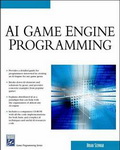| Меню сайта |
| Наше опитування |
| Реклама від Google |
|
Главная » 2009 Лютий 27 » AI Game Engine Programming
AI Game Engine Programming | 20:40 |
 Paperback: 624 pages Доступно тільки для користувачів
Publisher: Charles River Media; 1 edition (September 2004) Language: English ISBN-10: 1584503440 ISBN-13: 978-1584503446 AI Game Engine Programming provides game developers with the tools and wisdom necessary to create modern game AI engines. It takes programmers from theory to actual game development, with usable code frameworks designed to go beyond merely detailing how a technique might be used. In addition, it surveys the capabilities of the different techniques used. In addition, it surveys the capabilities of the different techniques used in some current AI engines, and covers common pitfalls, design considerations, and optimizations. If you're having difficulty determining which techniques to use, or looking for working code best suited to a particular game, you'll find the answers here. You'll also find a clean, usable interface for a variety of game AI techniques with an emphasis on primary decision-making paradigms. The book provides insightful coverage of a variety of subjects important to AI engine development, and ties them together masterfully to form an indispensable reference. Part I provides an overall look at game AI, covers the basic terminology used in the book, reviews underlying concepts of game AI, and dissects the parts of a game AI engine. Part II covers specific game genres (RPG, TRS, FTPS, Shooter, Sports, Racing, Strategy, Adventure, Fighting, Platform, and miscellaneous) and explains how they use different AU paradigms. It also covers the move common solutions to the problems posed by each genre. Some of the problems include, dealing with direct AI and human interactions, using scripting languages appropriately, and general intelligence/entertainment balancing. Part III provides the actual code implementations for the basic AI techniques such as finite state machines, fuzzy state machines, message board systems, scripted systems, and location-based information systems. And, Part IV covers the move advanced techniques, including genetic algorithms, neural networks, artificial life, planning algorithms, and decision trees. | |
| Категория: AI | Просмотров: 760 | Добавил: Admin | Рейтинг: 0.0/0 | | |
| Всего комментариев: 0 | |
| Форма входа |
| Календар новин | ||||||||||||||||||||||||||||||||||||||||||||||||
| ||||||||||||||||||||||||||||||||||||||||||||||||
| Пошук |
|
|
| Статистика |
|
Онлайн всього 1 Гостей 1 Користувачів 0 |